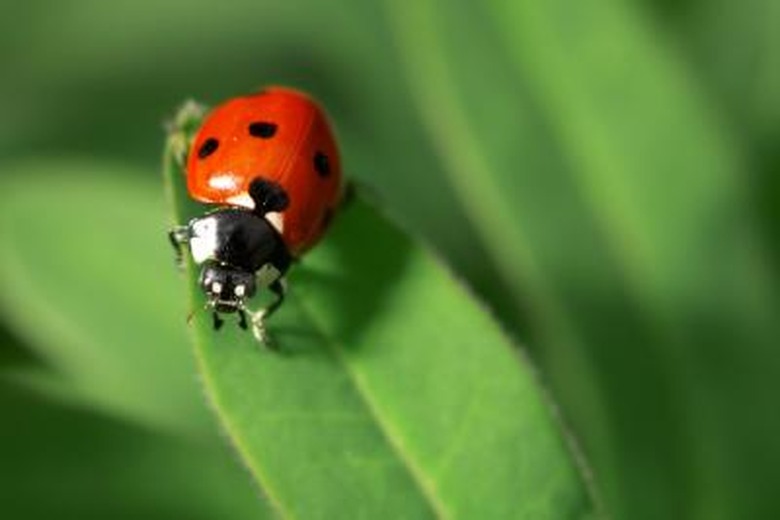Difference Between Male & Female Ladybugs
Ladybugs, also known as ladybird beetles or lady beetles, belong to the Coccinellidae family of beetles. They are not, as their common name suggests, all female beetles. These cheerfully vibrant, orange- to red-hued, spotted little beetles are known for their beneficial control of aphids and other pests. While their rounded, spotted appearance does not immediately display a difference between females and males, there are subtle characteristics of sexual dimorphism.
TL;DR (Too Long; Didn't Read)
While male and female ladybugs appear very similar, they do display subtle physical differences in size, shape and pigmentation. Additionally, females and males exhibit behavioral differences.
General Characteristics of Ladybugs
General Characteristics of Ladybugs
Ladybugs undergo a life cycle from egg, to larva, to pupa, to adult. Eggs hatch within three to five days. Upon hatching, ladybug larvae prove to be voracious eaters and consume the same prey as adults (typically aphids). Occasions of larval cannibalism occur. After the larvae molt, they enter the pupa stage. Adults then emerge from the pupa in the form of domed bodies in a vivid orange to red color, with black spots on their wings. Some ladybugs, however, have no spots at all. Adult ladybugs will consume thousands of pests over the course of their lives. Ladybugs aggregate in large numbers in colder seasons, and some ladybugs infiltrate people's homes at these times. Ladybugs secrete a substance from their leg joints that tastes foul to potential predators, and the bright color and spot combination of a ladybug signals a warning to predators to avoid eating them. Ladybugs can produce many generations in a year's time; these beetles live on average over a year.
Male Ladybugs
Male Ladybugs
Determining sex in ladybugs can prove to be challenging in the field. Nevertheless, there are ways to distinguish between the very similar-looking beetles. Males tend to be smaller than females and have slightly longer antennae in some species, such as the Asian lady beetle. In males, the distal margin of the seventh (fifth visible) abdominal sternite (abdominal segment) is concave in shape. Males also display lighter pigmentation of their labrums (front liplike structure) and prosternums (a collarlike structure under the head). Most ladybug species' males also show prominent, pale anterior coxal spots and femoral stripes. Male ladybugs of intermediate age, from 20-30 days old, make better mates than younger males and older males, in terms of fertilized egg viability.
Female Ladybugs
Female Ladybugs
Females tend to be larger than males. They can be distinguished from males by the shape of the distal margin of the seventh (fifth visible) abdominal sternite; in females, the distal margin is convex. Additionally, females display dark pigmentation of their labrums and prosternums. Female ladybugs do not mate during their overwinter phase. This is called reproductive diapause. Females require sufficient food for their fecundity; well-fed females will produce more eggs. In convergent lady beetles, the females cannot simply eat any fruit or nectar or pollen to aid fecundity – they must eat aphids or live prey to reproduce. Unmated female ladybugs release volatile sex pheromones in the presence of aphids to attract males. Ladybugs prefer to lay eggs near aphid colonies so larvae will have an ample food supply upon hatching. Females assess the fitness of aphid colonies based on their density, their secretions and any chemicals released by the aphids. Some female ladybugs are promiscuous, with clutches comprised of eggs fertilized by more than one male.
While they look very similar at first glance, male and female ladybug beetles display many interesting and sometimes subtle differences in both appearance and behavior.
References
- Government of Canada: Ladybugs
- PLoS: First Evidence of a Volatile Sex Pheromone in Lady Beetles
- The Coleopterists Bulletin: Sexual Dimorphism in North American Coccinellids: Sexing Methods for Species of Coccinella L. (Coleoptera: Coccinellidae) and Implications for Conservation Research
- Journal of Insect Science: A Simple Method for In-Field Sex Determination of the Multicolored Asian Lady Beetle Harmonia Axyridis
- Pennsylvania State University College of Agricultural Sciences: Multicolored Asian Lady Beetle (Ladybug)
- BBC Earth: Pretty Ladybirds Are Disease-Ridden Cannibals
- University of Florida Institute of Food and Agricultural Sciences: Featured Creatures – Convergent Lady Beetle
- U. S. Department of Agriculture Agricultural Research Service: The Multicolored Asian Lady Beetle
Cite This Article
MLA
Hermance, Dianne. "Difference Between Male & Female Ladybugs" sciencing.com, https://www.sciencing.com/difference-between-male-female-ladybugs-5978072/. 22 November 2019.
APA
Hermance, Dianne. (2019, November 22). Difference Between Male & Female Ladybugs. sciencing.com. Retrieved from https://www.sciencing.com/difference-between-male-female-ladybugs-5978072/
Chicago
Hermance, Dianne. Difference Between Male & Female Ladybugs last modified March 24, 2022. https://www.sciencing.com/difference-between-male-female-ladybugs-5978072/
